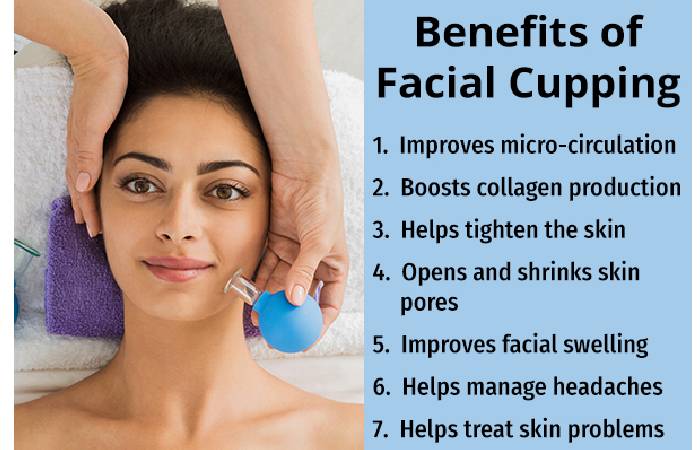Facial Cupping – Cupping is a different treatment that uses suction cups to arouse your skin and muscles. It can be performed on your face or your body.
The suction helps to increase the circulation of blood, which may assist in relieving muscle tension. It also helps cell repair and assists in other renewals.
Although the practice is deeply entrenched in Traditional Chinese Medicine, according to some reliable sources, the earlier symbolic records originated in ancient Egypt.
Facial Cupping – Functions
The suction cup sucks the blood under the skin. It drenches the nearby tissue with fresh blood and therefore increases new blood vessel formation.
Cupping also encourages hygiene inflammation. It is a form of pathogen-free suffering. We can also achieve cupping outcomes from powered trauma.
The vacuum-like suction divided different layers of tissues, resulting in micro trauma and tearing. It activates an inflammatory response, overflowing the area with white blood cells, platelets, and additional healing aids.
Facial Cupping – Benefits

Facial Cupping is helpful to:
- rise oxygen-rich blood flow
- toughen skin and connecter tissues
- arouse cells in charge of collagen production
- relax muscle tension
- improve skin
- diminish the presence of marks, fine lines, and wrinkles
- tone chin, jawline, neck, and neck
- lessening puffiness
- control oil making
- progress nutrient delivery and product absorption
Will it Leave Discolourations?
Facial Cupping doesn’t leave discolourations. However, staining can happen if the cup is left in a similar place for a long time. Discolouration can occur in as little as five seconds, so the cup should be moving continuously.
Facial Cupping – Side Effects or Risks?
While facial Cupping is usually considered harmless, it also has certain drawbacks. They typically happen at the time or quickly after the therapy.
You may practice momentarily:
- faintness
- dizziness
- nausea
- cold sweats
In an email meeting, Lana Farson, LAc and teacher at the Acupuncture beside Integrative Medicine College, directed against using facial Cupping on broken or inflamed skin. It has active breakouts and wounds.
Does Facial Cupping be Done at Home?
At home, there are cupping kits, but it is easier to relax under the care of an expert. maIty allows for a smoother application.
We can follow the proper technique by consulting an expert.
Ask your practitioner for guidance if you want to try cupping at home. They can reply to any questions you may have and may be able to endorse a decent home kit.
A word of caution: You may develop undesirable staining while you refine your method. It may also take longer to attain your desired results.
How to Start it?
There is a diversity of several cupping kits you can use. Some cups are manufactured from hard plastics, whereas others are soft and gel-like. Both can be equally operative, so it’s finally up to your choice.
Always follow the directions mentioned in your cupping kit.
General guidelines suggest these steps:
- Wash your face and mildly pat it dry.
- Slightly massage your face with your hands to leave initial tension.
- Although face oils are voluntary, smearing a light layer on your skin may help reduce your risk of staining as you move the cups.
- Begin by applying a small cup to your chin and around your mouth. Leave the cup in place for a few moments and then move upward to a new part.
- Switch smaller cups for more giant cups as required, like when you go to your forehead.
- Stay till you have successfully cupped all chosen parts.
- If you used a face oil, wash your face and pat dry. Otherwise, use a squish of warm water to reopen your pores.
- Continue with your beauty or skincare habit. Facial Cupping is said to raise product absorption, so now’s the time to apply.
You may notice minor redness and irritation afterwards. It is usual and should diminish within a few hours.
C.J., a first-year acupuncture student, favours cupping at night so that any irritation that arises disappears by morning.
Smaller cups function best on delicate parts, such as eyebrows, under your eyes, your nose and T-zone, and near your mouth. More giant cups work best on more extensive skin parts like your forehead, cheeks, and jaw.
How do I find a provider?
You can find a facial cupping practitioner by doing a simple Google search for resident acupuncturists who specify in facial transformation.
Acupuncture Nowadays, a major news outlet for Traditional Chinese Medicine, suggests an online directory of Chinese Medicine consultants all over America. You can improve your search to look for local practitioners specifying in Cupping or facial acupuncture.
Facial Cupping – Conclusion
Facial Cupping increases the circulation of blood. It may assist in lessening the visibility of fine lines and wrinkles. It also minimizes puffiness and more. We can perform the Facial Cupping at home, but it may be well to go to a well-experienced practitioner for your first cupping session. This practitioner gives replies to any of your questions. They can offer additional guidance for the best skin care.




GIPHY App Key not set. Please check settings